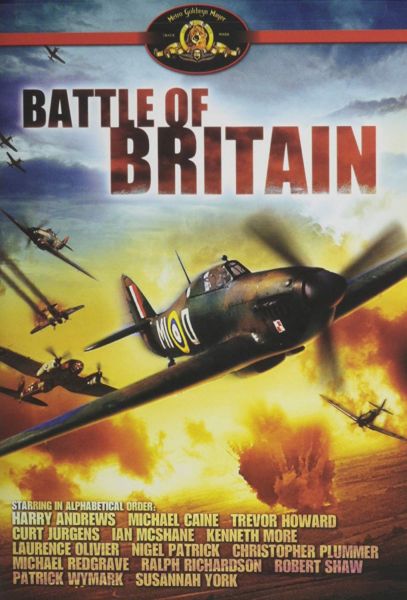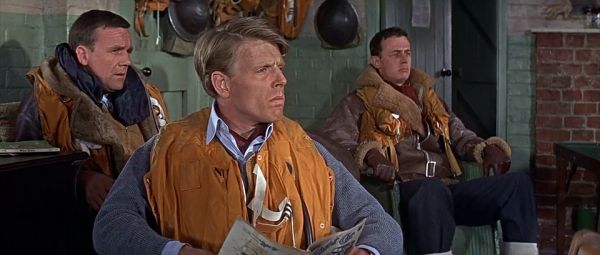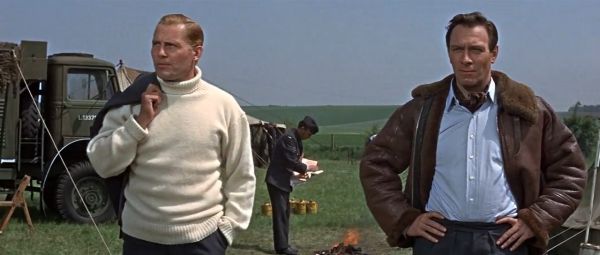The Battle of Britain movie from 1969
The Warrior Mindset
I watched The Battle of Britain on YouTube recently. It stars most of Britain's best actors from the 1960s, among them Laurence Olivier, Robert Shaw, and Michael Caine. YouTube offers it and other movies like Terminator, with Arnold Schwarzenegger, The Mask, with Jim Carrey and Cameron Diaz, and Fargo, with Frances McDormand and William H. Macy--alongside its usual cheapie dramas and sci-fi flicks.
When The Battle of Britain came out in 1969, it took a real beating from critics. All I could think was that none of the critics had ever experienced combat, nor even served in the military. Years ago, I asked a friend of my older sister what fighting in Vietnam was like. He was USMC and told me the War consisted of hours of boredom punctuated by moments of sheer terror.
Edward Fox in The Battle of Britain
A viewer has to remember that when he watches The Battle of Britain and sees pilots and support crew sitting around—the tedium of waiting—and engaging in seriously inane conversation until the dreaded phone call comes in, and they have to take to the skies once again. Once the fighting starts, a pilot has the dual task of defeating the enemy and staying alive through it all. Although they look depleted from the constant air-combat, they know they may have to scramble again and again, until the enemy breaks off the fight.
Robert Shaw, left, and Christopher Plummer, right
I also think none of the American critics really understands the British mindset and culture—the tendency to understate things. The British don't particularly like "foreign temperament," as John le Carré called it. "Mrs. Fennan . . . she is foreign, isn't she? That's what I put it down to—all her fuss and state—foreign temperament." (from Call for the Dead, 1961)
One critic complained that the film contained too many characters, and that they passed in and out of the plot before the viewer could connect with them. Really, you have to watch The Battle of Britain several times. Make a list of characters' names, and perhaps quote some of the defining dialogue. You could shape the list like a pyramid to convey the chain of command. The Battle of Britain is not simply an historical film; its ingrained sense of military procedures will mark it for veterans, who will enjoy the realism, even as they remember the tiresome pedantry of military life.
Laurence Olivier as Air Marshall Hugh Dowding
This movie has lots of commander-types giving orders. War as a collective effort and the chains of command tend to diminish an individual's sense of self. He plays his part with all the other pawns—just cogs in a great war-machine. The Battle of Britain has one other defining quality, inasmuch as it gives military history a literary take, like the novel War and Peace, which could serve as Battle's literary template, inasmuch as it presents a roster of characters playing small parts in a great human drama.
What the Reviewers Say
The Battle of Britain garnered only nine reviews on the internet movie-review aggregate Rotten Tomatoes, and most of them did not say good things about Battle. Iwondered if they watched the same film that I did.
1. Dennis Schwartz writes that the "all-star ensemble case . . . can't save the war epic from being a bore. . . . (T)he film lacked any spark, dramatics, or emotional appeal."
Schwartz, of course, expresses his own opinion. No one has yet invented a monitor that measures qualities like "spark" and "emotional appeal;" but he does appreciate the expectation of American film-goers, accustomed to eye-popping CGI and spectacular heroics by Tom Hanks, Harrison Ford, or Jennifer Lawrence to prevail against evil-doers. Schwartz, like any important critic, understands an audience that subsists on pablum-type films. The critics cater to them.
2. Roger Ebert wrote about Battle, "There are so many characters, we never get involved. We can't ever keep them straight." He also complains that the film never reconciles the "top-heavy special-effects" and the "thin" plot.
More than likely, neither critic saw the film more than once. Thanks to YouTube, a new generation of viewers can watch it as often as they like. Many have, apparently. Their comments on IMDb and YouTube vary from favorable to very favorable. Not surprisingly, many of the reviewers served in the military. Others had a personal connection to the Battle of Britain through their parents who witnessed it.
I have excerpted a few of their reviews for the benefit of my readers:
From IMDb:
bbhlthph review from 6 September 2010: I was a youth living near Hornchurch RAF aerodrome during this battle and vividly remember the hot sunny September afternoons when we could watch great aerial dogfights in the skies above almost every afternoon. We ducked into the shelter if the dogfights were directly overhead. . . . I avoided watching this film depecting the events for a very long time, as I did not want to come up with some lukewarm judgment that, yes, it was quite a good attempt to re-create what I remembered so well. The greatest compliment that I can pay this film is to acknowledge that I made a mistake. Watching it, I learned what it means to be transported back in time and to be present again during one of the great moments in history.
fpost2000-1 review from 2 January 2006: The producer (Szlomo Benjamin Fisz) shot down and killed Adolf Galland's (German war ace and technical advisor for The Battle of Britain) brother Hans. Fisz, the associate producer began and ran the whole project; Harry Saltzman put up $13 million dollars. Fisz was a Polish pilot in the RAF and he really did shoot down Galland's little brother. . . . The production was just crawling with B of B veterans. . . . Men like Norman Del Mar, the English Symphony conductor flew a fighter in that war. . . . I've talked with a few of "the few" and admire them tremendously.
From YouTube:
Hugh Morris, 2 months ago: Harry Saltzman of James Bond fame made this film when aircraft of the era (109s and 111s from the Spanish Air Force) and the men who flew them were still around. Check out the technical advisors for the film. Beautiful shots of the aircraft in flight, a stirring musical score depicting the critical battle for the skies over Great Britain in the Summer of 1940.
Don McMannamy, 2 months ago: Hugh Morris, You're right on the 109s and 111s. They were from the Spanish Air Force. At the time the movie was made, Spain was upgrading to more modern aircraft of the time. However all the ex-Spanish planes had Merlin engines—not what was in them during the war.
Jacob McCandles, 6 days ago: Aerial scenes were shot from a modified, privately-owned B-25 Mitchell. On the ground, the Hispano-built 109s look an awful lot like French Dewotine D-520s.
Aerospace Cadet, 19 hours ago: Those don't look like BF-109s to me. The pistons on the 109 face downward, thus the exhaust is towards the bottom of the nose. These have the exhaust toward the topside.
Don McMannamy, 19 hours ago: Aerospace Cadet, they are bf 109s, just that they were built after WW2 and were acquired by the Spanish Air Force when they were transitioning to jets.
Jacob McCandles,16 hours ago: Aerospace Cadet, It's the forward placement of the airscoop that makes them look strange to me, but they are Hispano Aviacion ha-1112-M1L "Buchon," the final bf-109 variant, fitted with a RR Merlin engine.
kevin harrington, 2 weeks ago: ". . . So don't threaten or dictate to us until you're marching up Whitehall, and even then we won't listen." Sir David Kelley, that British stubborness that Hitler could not comprehend.
Delavalmilker, 3 weeks ago: "The last little corporal who tried to cross the Channel came a cropper!" A very British retort.
Annamarie Dimola, 2 months ago: Love this film. Damn the critics! My admiration for the British, Polish, and other allied forces that participated in the Battle of Britain is unwavering. We wouldn't be enjoying the freedoms we now have, if they hadn't fought so hard then. God bless them all!
YouTube did not post The Battle of Britain until the 1st of March, this year. So interest in the film appears to be high, especially amongst aviation enthusiasts.
As the film ends, the camera focuses on the skies above London; the soundtrack reaches a kind of crescendo; and the war-time credits start to roll. Note the origins of the many pilots who flew for the RAF. Besides the 1300 or so British pilots, many foreign pilots also participated:
- New Zealand, 73 pilots, 11 killed in action;
- Canadian, 88 pilots, 20 killed in action;
- Polish, 141 pilots, 29 killed in action;
- Czech, 86 pilots, 8 killed in action;
- Belgian, 26 pilots, 6 killed in action;
Note also the governmental agencies and private organizations that contributed to the filming of this great movie:
- The Ministry of Defence;
- The Royal Air Force;
- The Spanish Air Force;
- The Royal Canadian Air Force;
- Imperial War Museum;
- Battle of Britain Fighter Association;
- Polish Air Force Association;
- and many others.
Warning: the air-combat scenes are intense. They are almost unbearable to watch. So many planes sharing the same space in the sky. They have to take care not to collide with one another.




